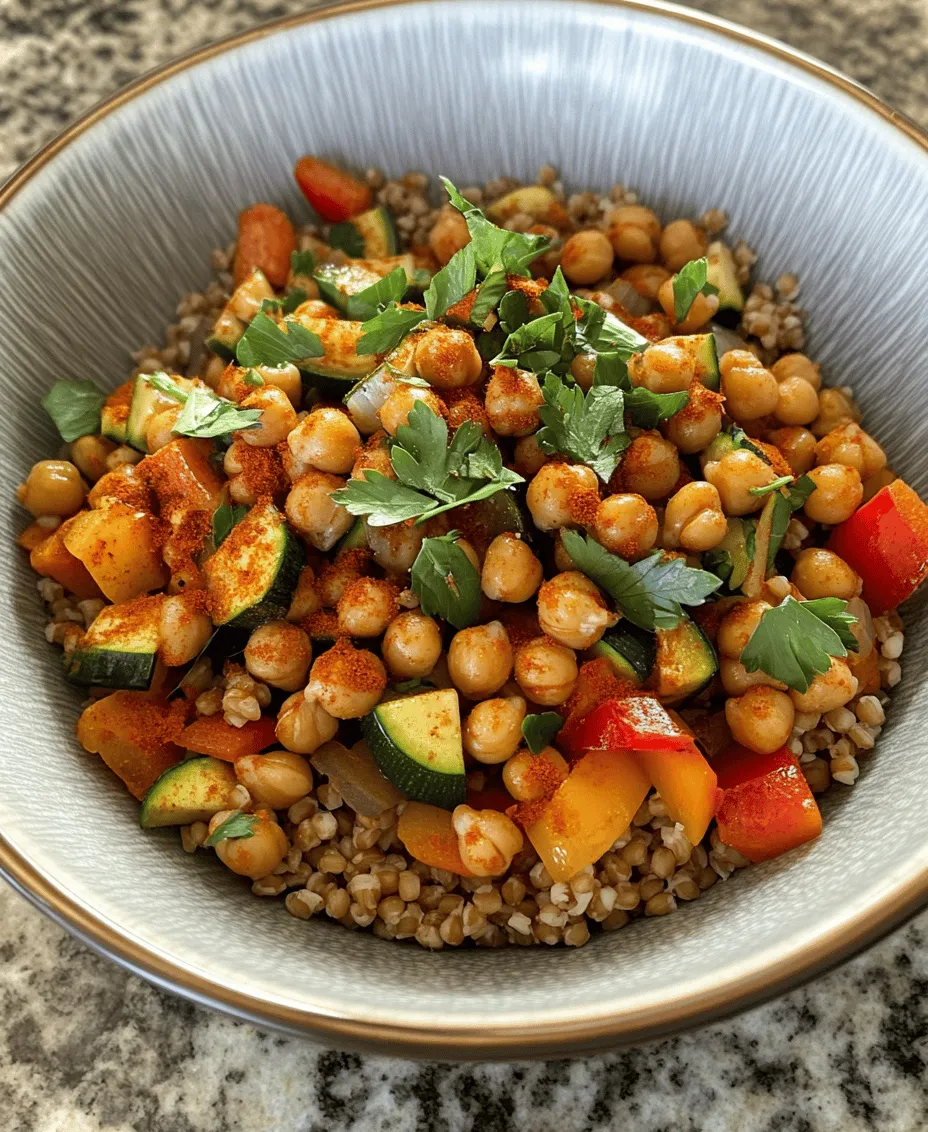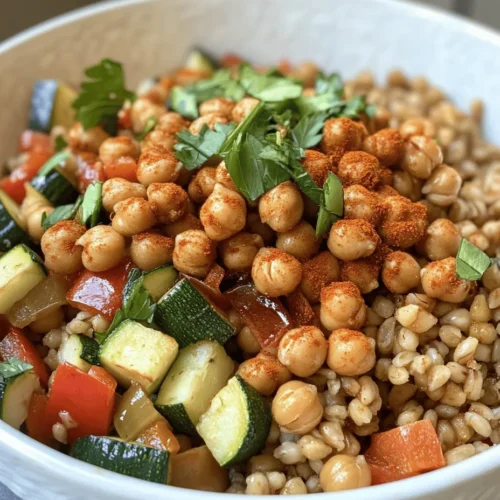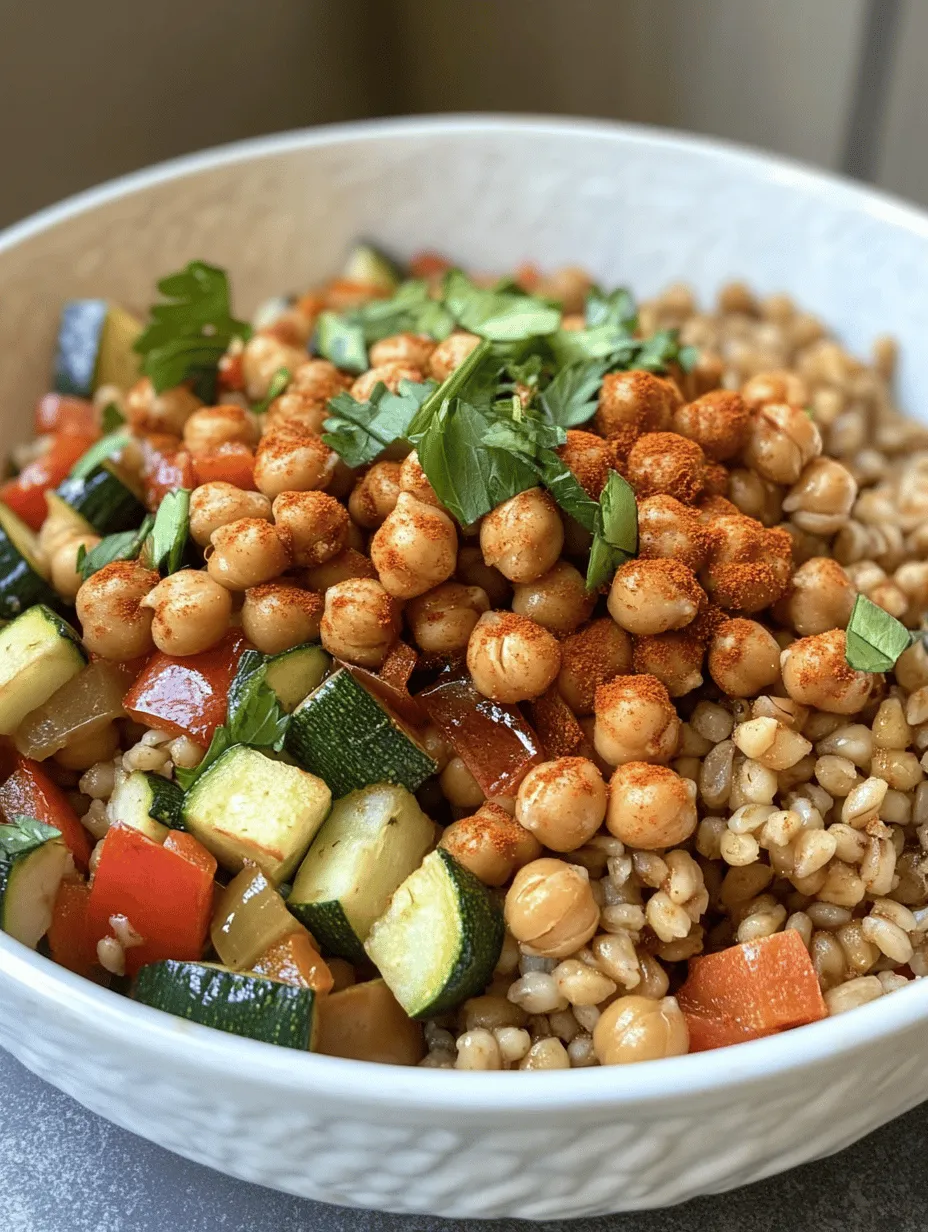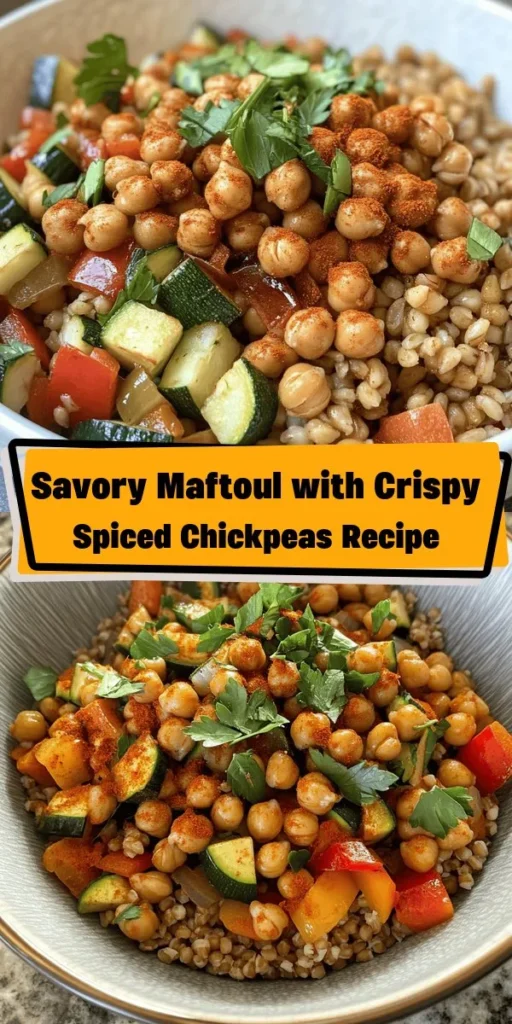Introduction
Maftoul, a staple in Middle Eastern cuisine, is a dish that embodies the region’s rich culinary traditions. Often referred to as “Palestinian couscous,” it consists of coarsely ground whole wheat that is rolled into pearls, offering a delightful texture and a nutty flavor. In this recipe, we will explore how to create a savory maftoul dish paired with spiced chickpeas and a vibrant medley of fresh vegetables. This dish not only showcases the unique flavors of the Middle East but also highlights the importance of whole grains and legumes in a balanced diet.
Whole grains, such as maftoul, are essential for a nutritious diet, providing a wealth of dietary fiber, vitamins, and minerals. When combined with legumes like chickpeas, which are packed with protein and healthy fats, this dish becomes a powerhouse of nutrition. The marriage of maftoul and spiced chickpeas in this recipe is not just about flavor; it’s about creating a wholesome meal that nourishes the body and pleases the palate.
In the following sections, we’ll take a deeper dive into the world of maftoul, including its cultural significance, nutritional benefits, and the key ingredients that make this dish so special. We’ll also walk through the step-by-step preparation, ensuring that you can recreate this delightful dish in your own kitchen.
Understanding Maftoul: A Cultural and Nutritional Insight
Definition and Origins of Maftoul
Maftoul is a traditional dish that has its roots in the Levant region, specifically in Palestine and Jordan. It is made from whole wheat flour that is moistened and rolled into small, round grains, similar to couscous. The process of making maftoul involves several steps, including soaking, steaming, and drying, which not only enhances its flavor but also contributes to its nutritional profile.
Historically, maftoul has been a staple in Middle Eastern households, often served during festive occasions and family gatherings. It serves as a foundation for various dishes, where it is typically paired with stews, meats, or vegetables. As the global interest in healthy eating continues to rise, maftoul has gained popularity as a nutritious alternative to refined grains, making it a sought-after ingredient in contemporary cuisine.
Nutritional Benefits of Whole Wheat Maftoul
When compared to traditional couscous, whole wheat maftoul stands out for its superior nutritional benefits. Whole grains retain the bran, germ, and endosperm of the grain, which means they are rich in fiber, B vitamins, and essential minerals such as iron and magnesium. This fiber content aids digestion, helps maintain a healthy weight, and can lower the risk of chronic diseases such as heart disease and diabetes.
Furthermore, the complex carbohydrates in whole wheat maftoul provide sustained energy, making it an excellent choice for anyone seeking a balanced meal. The nutty flavor of maftoul also enhances the overall taste of dishes, allowing for a satisfying and hearty experience.
Cultural Significance of Maftoul in Middle Eastern Cuisine
In Middle Eastern culture, food is not just about sustenance; it is a way of bringing people together. Maftoul has been a part of family gatherings and celebrations for generations, symbolizing hospitality and love. Traditionally, it is served as a communal dish, where family members gather around the table to share a meal, reflecting the values of unity and togetherness.
The preparation of maftoul can also be a communal activity, often involving multiple generations working together to create this beloved dish. This cultural significance is what makes maftoul more than just a meal; it is a representation of heritage, tradition, and the bonds that unite families and communities.
Ingredients Breakdown
To create a deliciously savory maftoul with spiced chickpeas, you will need a selection of high-quality ingredients that combine for a flavorful experience. Here’s a breakdown of the key components:
Whole Wheat Maftoul and Its Health Benefits
The star of this recipe is whole wheat maftoul, which serves as the base for the dish. It is easily found in Middle Eastern grocery stores or online. The health benefits of whole wheat maftoul include its high fiber content, which aids in digestion and promotes a feeling of fullness. Additionally, it provides essential nutrients that support overall health.
Role of Olive Oil in Cooking and Flavor Enhancement
Extra virgin olive oil is another crucial ingredient in this recipe. Known for its rich flavor and numerous health benefits, olive oil is a staple in Mediterranean cuisine. It contains healthy monounsaturated fats that can help reduce inflammation and lower the risk of chronic diseases. In the context of this dish, olive oil is used to sauté vegetables and enhance the overall flavor profile of the maftoul.
Spices: Cumin, Coriander, Smoked Paprika, and Cayenne Pepper
The spices used in this recipe are vital for creating depth and complexity in flavor.
– Cumin offers a warm, earthy taste and is known for its digestive benefits.
– Coriander adds a citrusy note that brightens the dish.
– Smoked paprika lends a subtle smokiness that elevates the overall flavor.
– Cayenne pepper provides a kick of heat, which can be adjusted according to personal preference.
Each of these spices not only enhances the taste of the dish but also offers various health benefits, making them a valuable addition to any meal.
Importance of Using Fresh Vegetables in the Vegetable Medley
Fresh vegetables are essential for adding color, texture, and nutrition to the dish. A vibrant vegetable medley can include bell peppers, zucchini, carrots, and onions, each contributing their unique flavors and health benefits. Fresh vegetables are packed with vitamins, minerals, and antioxidants that support overall health and well-being.
Discussion on the Versatility of Chickpeas in Various Cuisines
Chickpeas are the perfect complement to maftoul, serving as a protein-rich legume that adds heartiness to the dish. Their versatility allows them to shine in various cuisines around the world, from Middle Eastern hummus to Indian chana masala. In this recipe, spiced chickpeas are sautéed with aromatic spices to create a flavorful topping for the maftoul, making it a satisfying and nutritious meal.
Step-by-Step Preparation of the Dish
Now that we’ve covered the ingredients and their significance, let’s dive into the step-by-step preparation of this savory maftoul with spiced chickpeas.
Preparing the Maftoul
1. Toast the Maftoul: Begin by toasting the whole wheat maftoul in a dry skillet over medium heat. Stir frequently to ensure even toasting. This step is crucial as it enhances the nutty flavor of the maftoul and adds depth to the dish. Toasting usually takes about 5-7 minutes until the grains are lightly golden and fragrant.
2. Prepare the Broth: In a separate pot, bring vegetable broth to a boil. You can also use chicken broth for added flavor, depending on your dietary preferences. The broth will not only cook the maftoul but also infuse it with flavor.
3. Cook the Maftoul: Once the broth is boiling, add the toasted maftoul to the pot. Stir well, cover, and reduce the heat to low. Allow the maftoul to simmer for about 15-20 minutes, or until it has absorbed all the liquid and is tender. Fluff it with a fork to separate the grains.
Cooking Spiced Chickpeas
1. Sauté Aromatics: In a large skillet, heat a couple of tablespoons of extra virgin olive oil over medium heat. Add diced onions and sauté until they become translucent. This step lays the foundation for the flavor in your spiced chickpeas.
2. Add Spices: Once the onions are softened, add minced garlic, cumin, coriander, smoked paprika, and cayenne pepper. Stir for about 30 seconds until the spices are fragrant.
3. Incorporate Chickpeas: Drain and rinse canned chickpeas (or soak and cook dried chickpeas if you prefer) and add them to the skillet. Stir to coat the chickpeas in the spice mixture, cooking for another 5-7 minutes until they are heated through and slightly crispy.
4. Finish with Fresh Ingredients: For a burst of freshness, add chopped parsley or cilantro just before serving. This will enhance the flavor and add a lovely color contrast to the dish.
With the maftoul cooked to perfection and the spiced chickpeas ready, you are now set to assemble this delicious dish. The combination of flavors and textures will surely impress anyone you serve it to, making it a fantastic addition to your recipe repertoire.

Roasting Techniques for Achieving Crispiness
When it comes to preparing the spiced chickpeas for your savory maftoul dish, mastering the art of roasting is essential to achieving that perfect crispiness. Roasting not only enhances the texture of the chickpeas but also deepens their flavor profile. Start by preheating your oven to 400°F (200°C). Rinse and drain your canned or cooked chickpeas thoroughly, then spread them on a clean kitchen towel or paper towel to dry. Removing excess moisture helps achieve a crunchy exterior.
Once dried, transfer the chickpeas to a mixing bowl, and toss them with a drizzle of olive oil, salt, and your choice of spices—cumin, paprika, and cayenne work well for a flavorful kick. Spread the seasoned chickpeas in a single layer on a baking sheet lined with parchment paper. This ensures even cooking and allows air to circulate around each chickpea, promoting that sought-after crispiness. Roast in the preheated oven for about 25-30 minutes, stirring halfway through to ensure uniform browning. Keep an eye on them toward the end; they can quickly go from perfectly roasted to overdone.
Flavor Infusion Through Spices and Olive Oil
The key to elevating the flavor of your spiced chickpeas lies in the careful selection and application of spices, along with the use of high-quality extra virgin olive oil. Olive oil not only aids in the roasting process but also provides a rich, fruity base that complements the spices. To infuse flavors effectively, consider warming the olive oil in a pan before adding your spices. This technique helps release the essential oils in the spices, creating a more aromatic and flavorful coating for the chickpeas.
For a robust flavor, try toasting whole spices, such as cumin seeds or coriander seeds, in the oil before mixing them with the chickpeas. This will enhance their natural flavors and add depth to the dish. Experiment with different spice blends to find your perfect combination. Consider adding a hint of garlic powder or onion powder for an additional layer of flavor that marries well with the chickpeas’ nuttiness.
Sautéing the Vegetable Medley
While the chickpeas are roasting, you can prepare a vibrant vegetable medley that will serve as the perfect accompaniment. Begin with a selection of seasonal vegetables—bell peppers, zucchini, and carrots work beautifully together. Chop the vegetables into uniform pieces for even cooking, ensuring they maintain their textures while sautéing.
Heat a tablespoon of olive oil in a large skillet over medium heat. Add the chopped vegetables and sauté for about 5-7 minutes, stirring frequently. The goal is to soften the vegetables while keeping them slightly crisp. Adding a pinch of salt at this stage will help draw out moisture, enhancing the overall flavor.
For an added depth of flavor, consider adding aromatics like minced garlic or shallots just a minute or two before the vegetables are done cooking. This will prevent them from burning while allowing their flavors to meld with the vegetables. Remember to taste as you go—this is crucial for achieving the perfect balance of flavors in your dish.
Techniques for Maintaining Vegetable Texture and Flavor
To ensure that your sautéed vegetables retain their texture and vibrant colors, it’s essential to avoid overcrowding the pan. If your skillet is too crowded, the vegetables will steam rather than sauté, leading to a mushy consistency. If necessary, sauté in batches to keep that perfect bite. Additionally, consider adding vegetables with varying cooking times first; for instance, add carrots before bell peppers, as they require more time to soften.
Another important aspect of maintaining flavor is to finish your vegetable medley with a splash of lemon juice. This not only brightens the dish but also adds a refreshing acidity that balances the richness of the olive oil and the earthiness of the chickpeas. Just a tablespoon or two will enhance the overall flavor profile without overpowering the other ingredients.
Assembling the Dish: Bringing It All Together
Now that your spiced chickpeas and sautéed vegetable medley are ready, it’s time to assemble your savory maftoul dish. Begin by fluffing the maftoul with a fork to ensure it’s light and airy. In a large serving bowl, combine the fluffy maftoul with the roasted chickpeas and sautéed vegetables. Gently toss everything together to ensure that the flavors meld and the chickpeas and vegetables are evenly distributed throughout the grains.
For an appealing presentation, consider layering the maftoul on the bottom, followed by the chickpeas and then the vegetable medley on top. This not only looks beautiful but also allows the vibrant colors of the vegetables to shine. To finish, garnish the dish with freshly chopped parsley or cilantro for a pop of color and freshness.
Tips for Presentation and Garnishing with Parsley
Presentation can elevate your dish from simple to stunning. When garnishing, use fresh herbs like parsley or cilantro to add brightness and contrast against the earthy tones of the maftoul and chickpeas. Consider serving the dish in a large, shallow bowl or on a beautiful platter for a family-style presentation.
You can also drizzle a bit of high-quality olive oil on top before serving, which adds a glossy finish and enhances the flavors. For an extra touch, sprinkle some toasted pine nuts or slivers of almonds over the top, adding a delightful crunch and additional visual appeal.
Suggestions for Serving Ideas and Pairings
Savory maftoul with spiced chickpeas can be enjoyed on its own as a hearty, nutritious meal, or it can be served alongside various dishes. Consider pairing it with a refreshing cucumber and yogurt salad, which provides a cooling contrast to the spices. Additionally, a side of roasted or grilled vegetables can enhance the meal, adding more nutrients and flavors that complement the maftoul.
For a complete Middle Eastern experience, serve this dish with a side of hummus and pita bread. This combination not only enriches the flavor profile but also adds texture and variety to your meal. If you’re looking to incorporate proteins, grilled chicken or lamb can also be excellent accompaniments, providing a satisfying balance to the meal.
Nutritional Analysis of the Finished Dish
When it comes to nutrition, this savory maftoul dish is packed with health benefits. A typical serving of maftoul, combined with spiced chickpeas and sautéed vegetables, contains approximately 350-400 calories. The macronutrient breakdown per serving is roughly as follows:
– Carbohydrates: 50g
– Protein: 15g
– Fat: 12g
– Fiber: 10g
The chickpeas are a fantastic source of plant-based protein and fiber, which aids in digestion and helps keep you feeling full. The vegetables add essential vitamins and minerals, while the olive oil provides healthy fats, contributing to heart health.
Furthermore, this dish is inherently vegan and can easily be made gluten-free by ensuring that the maftoul is made from gluten-free grains. This makes it suitable for a wide range of dietary preferences, promoting inclusivity in your meal planning.
Creative Ways to Serve Maftoul with Spiced Chickpeas
There are endless possibilities when it comes to serving maftoul with spiced chickpeas. For a fun twist, consider creating a maftoul bowl, where you layer ingredients like roasted sweet potatoes, avocado, and a drizzle of tahini sauce. This not only adds different flavors but also introduces a variety of textures.
Another creative idea is to use the maftoul mixture as a filling for stuffed bell peppers. Hollow out bell peppers, fill them with the maftoul, chickpeas, and vegetables, and then bake until the peppers are tender. This makes for an eye-catching presentation and a delicious way to enjoy the dish.
Suggested Side Dishes or Complementary Recipes
To round out your meal, consider serving a light soup, such as a lemony lentil soup or a refreshing tomato and cucumber salad. These dishes can complement the savory flavors of the maftoul while adding a refreshing contrast.
If you want to explore more flavors, you might also enjoy a tangy tabbouleh salad or baba ghanoush. Both are traditional Middle Eastern dishes that pair beautifully with maftoul and provide a delightful variety of textures and tastes.
Variations to Accommodate Different Dietary Preferences
This savory maftoul dish is versatile enough to accommodate various dietary preferences. For those looking to add more protein, consider incorporating roasted chicken, falafel, or grilled shrimp. For a heartier vegetarian option, add roasted butternut squash or chickpea flour fritters.
You can also experiment with different spices to create unique flavor profiles. For instance, try adding harissa for a spicy kick or turmeric for a warm, earthy flavor. Additionally, you can swap out the vegetables based on what’s in season or what you have on hand, ensuring that your meal is both fresh and adaptable.
Conclusion
In summary, savory maftoul with spiced chickpeas is a delightful dish that combines rich flavors, diverse textures, and numerous health benefits. The combination of roasted chickpeas, sautéed vegetables, and fluffy maftoul creates a satisfying meal that is both nutritious and enjoyable.
This dish represents the cultural significance of grains and legumes in Middle Eastern cuisine, showcasing the importance of incorporating diverse ingredients into everyday meals. By trying your hand at this recipe, you not only explore new flavors but also embrace the health benefits that come from whole grains and plant-based proteins.
So why not gather your ingredients and make this delicious dish at home? Experience the rich flavors and aromas that will fill your kitchen, and savor every bite of this unique culinary creation. Incorporating such wholesome meals into your diet can pave the way for better health and a greater appreciation for diverse cuisines.



